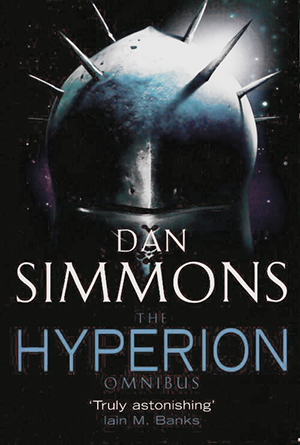kferrand reviewed The Hyperion Omnibus by Dan Simmons
The Hyperion Omnibus
4 stars
Content warning Some plot developments
Hyperion, Hyperion, Hyperion. Since I started frequenting internet science fiction related newsgroups and forums in the early 1990s, one book has been recommended to me more than any other and it seems to have gathered steam again in the past few years. Dan Simmon’s Hyperion, written in the late 1980s at times seemed to be everyone’s favourite book. Eclipsed briefly a few years later by Vernor Vinge’s A Fire Upon the Deep and now neck and neck with Peter Watt’s Blindsight (at least on Reddit) Hyperion as become a modern fan favourite. I took me until 2 years ago to actually buy a copy to see what all the fuss was about. Learning there were actually 4 volumes in the so-called Hyperion Cantos I chose to buy an Omnibus edition containing the first pair – Hyperion itself and the direct follow-up The Fall of Hyperion. The remaining pair are said to be less essential but I also acquired them in eBook form just in case I decide to go down the completist route someday.
Hyperion itself is a meticulously crafted science fiction novel the majority of which takes the form of a classic ‘travellers tales’ narrative. I’m sure you know what I mean without giving too many examples…it’s been done for hundreds of years and Hyperion itself seems to have influenced even more recently (which I only now recognise after reading it). Simply put, a group of disparate characters are drawn together on a journey and to pass the time they each tell their background story and we slowly see what connects them together. In this case it’s the mysterious planet of Hyperion itself – 7 ‘pilgrims’ have been offered the chance to go there and sort out whatever mess their lives has become. Most have been there before and need to perform a certain task or find answers that have eluded them since their last visit.
The planet Hyperion is in the backwaters of a large future human empire known as the Hegemony, connected together by both starships and instantaneous travel portals. The linked core ‘Web’ planets range from hard core industrial to idyllic. Humanity has survived the destruction of earth and the threat of Artificial Intelligences who seem to have settled into an uneasy peace with them. The major external threat seems to be the ‘Ousters’ which the text initially seems to lead you to believe are classic belligerent aliens of some sort – (spoilers!) they are later revealed to be space-adapted humans who spit off from the rest of mankind into space hundreds of years ago. For largely unclear reasons the Hegemony and the Ousters have been involved in destructive skirmishes. And now the Ousters are on the way to capture the remote but apparently strategically important Hyperion.
Why is Hyperion so special? The AIs believe it is a random factor that could alter any predicted future. On the surface there are structures known as the “Time Tombs” protected by advanced temporal fields and apparently about to release what they’ve held for thousands for years (or – spoliers!) will hold far into the future. Connected to the Time Tombs is the ‘Shrike’ a malevolent bio-mechanical entity who strikes at will bringing ruin to all who encounters him. Seen as a representation of death itself, the Shrike has inspired religions and cults both on the planet and across the Hegemony. Nobody quite understands the Shrike’s purpose or motivation but somehow our brave plucky band of pilgrims are directly connected to the being.
So, one by one we get the pilgrim’s stories ranging from a priest of the near extinct catholic faith (the first and possibly the best story) through to a defeated poet, a hard-bitten female private detective and a guilt-wracked former political Consul. The pilgrims' stories are each like mini-novels, almost of different genres and styles. The priest story is almost horror while the detective’s is a near pastiche of the then-so-hot cyberpunk milieu.
There’s also a simpler linking narrative that describes their journey and its hardships. Just as they reach the ancient Time Tombs and related structures the reader thinks some mysteries are about to be solved and is sorely disappointed when the book ends. What??
Never fear for this is the Omnibus edition and after a week or so break I launched into the sequel The Fall of Hyperion. Even though it directly follows the first book’s story it is quite a different beast. Gone is the travellers’ tales’ structure, instead at least initially, we have chapters featuring the political machinations of the Hegemony as it faces total war alternating with the further adventures of the pilgrims on Hyperion. The linking character is a certain M. Severen, a living AI who is closely related to another such being who played a key part in the original book’s detective’s tale. By day he is a close consort of the Hegemony CEO, at night he somehow dreams what the remaining pilgrims are doing on Hyperion. (spoilers!) In a surprise move, the Ousters seem to gather the resources to attack many of the major Web planets at once while most of humanity’s forces remain concentrated trying to hold on to Hyperion.
Much happens both with the pilgrims and the apparent interstellar war, probably too much to be honest. Then the AIs, their factions and ultimate plans are thrown into the mix. Who is the real enemy of mankind? I felt much of the mystery built up by the first book was squandered here. The answers to everything – Hyperion’s importance, the shrike, the pilgrims etc seems to be all related to the schemes and desires of artificial time-bending god-like beings I couldn’t really care about.
There’s a heady mix of philosophy, theology and poetry woven into the story, which unfortunately sometime just seems needlessly pretentious.
That’s not to say there aren’t wonderful sections in the second book, it’s still high-quality science-fiction but fails to reach the peaks of the first volume, at least for me.
It took me a long time to finally read the Omnibus. Hyperion lives up to the hype but maybe leave it at that.

